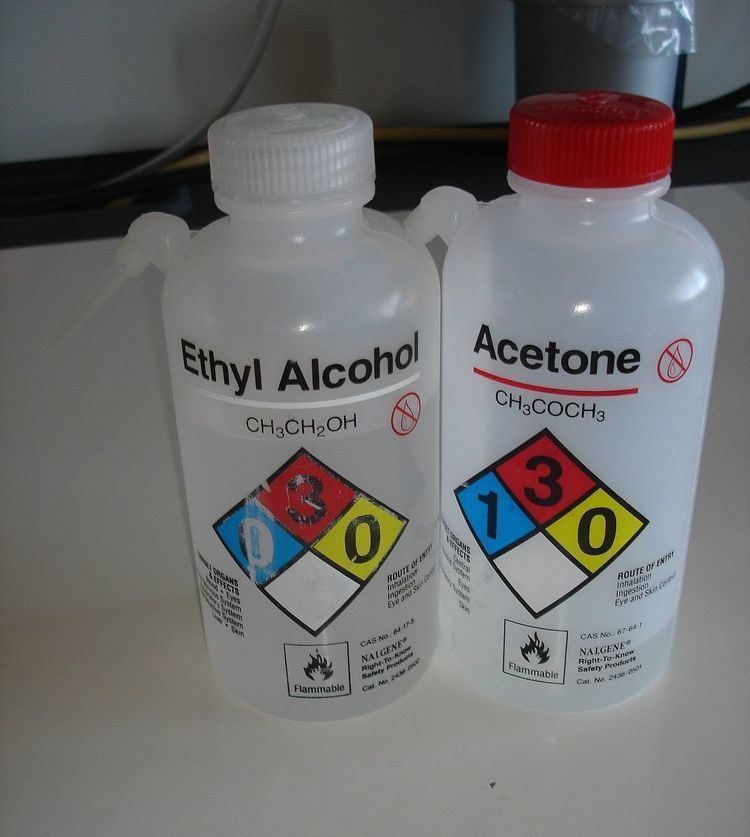 | ||
Nalgene is a brand of plastic products developed originally for laboratory use, including such items as jars, bottles, test tubes, graduated cylinders, and Petri dishes, that were shatterproof and lighter than glass. The properties of plastic products make them suitable for work with many substances in various temperature ranges.
Contents
Nalgene products are manufactured by Nalge Nunc International, which in 2004, became a subsidiary of Fisher Scientific, now Thermo Fisher Scientific. The name Nalgene is a registered trademark.
Nalgene Outdoor
In the 1970s, conservationists began discouraging the reckless approach to disposal of cans and glass bottles through burning and burial in wilderness and recreation areas, and some places began forbidding such materials by regulation. Nalgene products became popular replacements among backpackers for storing consumables; the light, wide-mouthed high-density polyethylene (HDPE) and Lexan bottles were more secure than plastic bags and were used for both liquids and solid foods.
Originally, wilderness travelers purchased Nalgene products through laboratory-equipment suppliers (or perhaps gained access to them in their workplaces). Company lore has it that Nalge Company president Marsh Hyman discovered that his son's Boy Scout troop was using Nalgene lab containers when camping. Since then, the company has re-packaged and marketed items for consumer sales through their line of Nalgene Outdoor Products. By the late 1990s, the "Nalgene" trademark was recognized by many hikers, and sales of the 1-litre wide-mouth bottle of translucent polycarbonate (originally typically grey, but now commonly in bright colors, often with custom labels made for the bottle retailer) with a screw-on plastic top that stays attached when the bottle is open, began to increase. Today, many hikers and others recognize the distinctive appearance of Nalgene-branded bottles. Its laboratory pedigree is still suggested by the markings, in hundreds of millilitres, of the volume contained. The materials resist stains and odors absorption, and can be filled with with boiling water. The wide-mouth bottle is more widely used and sold over the narrow-mouth bottles in sub-freezing conditions, since it is easier to break through ice in the wider mouth. Currently, Nalgene markets over 10 different kinds of bottles, including the classic Wide Mouth and Narrow Mouth.
A variety of products from other manufacturers are designed for compatibility with this item's overall dimensions or its 2.5-inch neck; these include:
Another widely available Nalgene Outdoor product is a 650 ml (22 fl oz) "All-Terrain" or "bike" bottle. The bottle itself is made from low-density polyethylene (LDPE), and its screw top has two moving parts: a drinking nozzle that seals until snapped open by pulling on it, and a hinged Lexan dome, that when closed both snaps the nozzle closed and protects the nozzle against contamination. Unlike traditional Nalgene containers, this item can be damaged and potentially ruined by filling it with very hot water.
Recently, Nalgene has added hydration systems to its cycling and wilderness product line. The line features 1- to 3-litre bladders with hose-and-bite-valve assemblies in small back-carried packs (mostly under 1000 cubic inches (16 L) of additional storage). Nalgene offers the option of two different bladder materials for a choice of superior taste and bacteria resistance versus improved durability. In addition, the bladder on these products can be quickly detached from the hose and pack by a self-sealing connector on the bladder. These features were intended to improve on perceived issues with existing hydration systems, including difficulty filling and/or leaking water into gear that shares the pack.
Increased awareness of the importance of hydration while exercising has led to the appearance of some Nalgene containers in urban and suburban settings like gyms, offices, and campuses. Many colleges give or sell Nalgene water bottles to their students, and Nalgene bottles are also customized and sold as retail promotions.
Animal testing boycott
In 1997 Nalgene was targeted in a nationwide boycott by campus-based animal rights activists for products used in animal experimentation. The majority of company criticism was directed towards a Nalgene device that prevents rabbits from breaking their own backs during pyrogen (a fever-inducing drug) testing. The company has responded with an official statement that it supported research "conducted only within the guidelines of the federal Animal Welfare Act and only when necessary".
BPA concerns
In recent years, studies have suggested that polycarbonates, made from bisphenol A (BPA) and phosgene (COCl
2), such as the ones Nalgene used, may leach endocrine disruptors including BPA. Nalgene denies that the quantity leached from their products posed a significant threat to health. Among the secreted chemicals, BPA is a concern, as it binds to estrogen receptors, thus altering gene expression. Other research has found that fixatives in polycarbonate plastics can cause chromosomal error in cell division called aneuploidy. Nalgene claims these chemicals are only potentially released from Nalgene products when used at temperatures outside of the designed range.
In November 2007, national Canadian co-operative retailer Mountain Equipment Co-op removed all hard, clear polycarbonate plastic water bottles (including Nalgene-branded product) from their shelves and replaced them with BPA-free Nalgene bottles. In December 2007, Lululemon made a similar move. In May 2008, REI removed Nalgene-branded polycarbonate water bottles and replaced them with BPA-free Nalgene bottles.
On April 18, 2008, Health Canada announced that bisphenol A is "'toxic' to human health". On the same date, Nalgene announced it would phase out production of its Outdoor line of polycarbonate containers containing the chemical bisphenol A (BPA). Nalgene subsequently adopted Tritan, a BPA-free copolyester made by Eastman Chemical, as a substitute.
While unpublished studies in 2008 and 2009 by Oregon State students suggest that BPA does not leach from polycarbonate plastic under extreme conditions, BPA is not the only component of plastics which can mimic estrogen and act as an endocrine disruptor. Unfortunately, BPA-free Tritan plastics were later found to leach other estrogenic chemicals in a cell-based assay. Eastman Chemical, the manufacturer of Tritan, will not disclose any information about this product or its composition.
